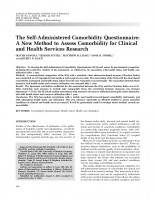Download
| File Size | 90.2 KiB |
|---|---|
| Date | August 31, 2013 |
| Downloads | 0 |
Objective. To develop the Self-Administered Comorbidity Questionnaire (SCQ) and assess its psychometric properties, including the predictive validity of the instrument, as reflected by its association with health status and health care utilization after 1 year.
Methods. A cross-sectional comparison of the SCQ with a standard, chart abstraction-based measure (Charlson Index) was conducted on 170 inpatients from medical and surgical care units. The association of the SCQ with the chart-based comorbidity instrument and health status (short form 36) was evaluated cross sectionally. The association between these measures and health status and resource utilization was assessed after 1 year.
Results. The Spearman correlation coefficient for the association between the SCQ and the Charlson Index was 0.32. After restricting each measure to include only comparable items, the correlation between measures was stronger (Spearman r
Methods. A cross-sectional comparison of the SCQ with a standard, chart abstraction-based measure (Charlson Index) was conducted on 170 inpatients from medical and surgical care units. The association of the SCQ with the chart-based comorbidity instrument and health status (short form 36) was evaluated cross sectionally. The association between these measures and health status and resource utilization was assessed after 1 year.
Results. The Spearman correlation coefficient for the association between the SCQ and the Charlson Index was 0.32. After restricting each measure to include only comparable items, the correlation between measures was stronger (Spearman r



